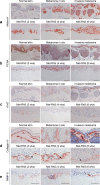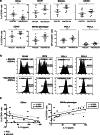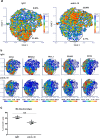Micro-environmental cross-talk in an organotypic human melanoma-in-skin model directs M2-like monocyte differentiation via IL-10
- PMID: 32507967
- PMCID: PMC7568725
- DOI: 10.1007/s00262-020-02626-4
Micro-environmental cross-talk in an organotypic human melanoma-in-skin model directs M2-like monocyte differentiation via IL-10
Abstract
Preclinical assessment of novel therapies to fight cancer requires models that reflect the human physiology and immune response. Here, we established an in vitro three-dimensional (3D) reconstructed organotypic human melanoma-in-skin (Mel-RhS) model to investigate cellular and molecular features of tumor formation over a period of 6 weeks. Tumor nests developed over time at the epidermal-dermal junction and spread towards the dermis, in places disrupting the basement membrane. This coincided with secretion of matrix metalloproteinase 9 (MMP-9) by melanoma cells. These features resemble the initial stages of invasive melanoma. Interestingly, while the SK-MEL-28 cell line did not secrete detectable levels of interleukin-10 (IL-10) in traditional two-dimensional monolayers, it did express IL-10 in the 3D Mel-RhS, as did the surrounding keratinocytes and fibroblasts. This cellular cross-talk-induced secretion of IL-10 in the Mel-RhS indicated the generation of an immune suppressive microenvironment. Culture supernatants from Mel-RhS interfered with monocyte-to-dendritic-cell differentiation, leading to the development of M2-like macrophages, which was in part prevented by antibody-mediated IL-10 blockade. Indeed, high-dimensional single-cell analysis revealed a shift within the monocyte population away from a CD163+PD-L1+ M2-like phenotype upon IL-10 blockade. Thus, the 3D configuration of the Mel-RhS model revealed a role for IL-10 in immune escape through misdirected myeloid differentiation, which would have been missed in classical monolayer cultures.
Keywords: IL-10; M2 macrophages; Melanoma; Reconstructed human skin; Tumor microenvironment; Tumor progression.
Conflict of interest statement
The authors declare no potential conflicts of interest.
Figures





Similar articles
-
A Reconstructed Human Melanoma-in-Skin Model to Study Immune Modulatory and Angiogenic Mechanisms Facilitating Initial Melanoma Growth and Invasion.Cancers (Basel). 2023 May 20;15(10):2849. doi: 10.3390/cancers15102849. Cancers (Basel). 2023. PMID: 37345186 Free PMC article.
-
Integration of line-field confocal optical coherence tomography and in situ microenvironmental mapping to investigate the living microenvironment of reconstructed human skin and melanoma models.J Dermatol Sci. 2024 Aug;115(2):85-93. doi: 10.1016/j.jdermsci.2024.07.001. Epub 2024 Jul 10. J Dermatol Sci. 2024. PMID: 39043504
-
Tumor cell-released autophagosomes (TRAPs) promote immunosuppression through induction of M2-like macrophages with increased expression of PD-L1.J Immunother Cancer. 2018 Dec 18;6(1):151. doi: 10.1186/s40425-018-0452-5. J Immunother Cancer. 2018. PMID: 30563569 Free PMC article.
-
The Ins and Outs of Chemokine-Mediated Immune Cell Trafficking in Skin Cancer.Front Immunol. 2019 Mar 7;10:386. doi: 10.3389/fimmu.2019.00386. eCollection 2019. Front Immunol. 2019. PMID: 30899263 Free PMC article. Review.
-
The Influence of Tumor Microenvironment on Immune Escape of Melanoma.Int J Mol Sci. 2020 Nov 7;21(21):8359. doi: 10.3390/ijms21218359. Int J Mol Sci. 2020. PMID: 33171792 Free PMC article. Review.
Cited by
-
In Vitro Three-Dimensional (3D) Models for Melanoma Immunotherapy.Cancers (Basel). 2023 Dec 9;15(24):5779. doi: 10.3390/cancers15245779. Cancers (Basel). 2023. PMID: 38136325 Free PMC article. Review.
-
A preclinical model of cutaneous melanoma based on reconstructed human epidermis.Sci Rep. 2022 Sep 29;12(1):16269. doi: 10.1038/s41598-022-19307-0. Sci Rep. 2022. PMID: 36175453 Free PMC article.
-
Comprehensive analysis of different tumor cell-line produced soluble mediators on the differentiation and functional properties of monocyte-derived dendritic cells.PLoS One. 2022 Oct 4;17(10):e0274056. doi: 10.1371/journal.pone.0274056. eCollection 2022. PLoS One. 2022. PMID: 36194602 Free PMC article.
-
A Reconstructed Human Melanoma-in-Skin Model to Study Immune Modulatory and Angiogenic Mechanisms Facilitating Initial Melanoma Growth and Invasion.Cancers (Basel). 2023 May 20;15(10):2849. doi: 10.3390/cancers15102849. Cancers (Basel). 2023. PMID: 37345186 Free PMC article.
-
An Organotypic Human Lymph Node Model Reveals the Importance of Fibroblastic Reticular Cells for Dendritic Cell Function.Tissue Eng Regen Med. 2024 Apr;21(3):455-471. doi: 10.1007/s13770-023-00609-x. Epub 2023 Dec 19. Tissue Eng Regen Med. 2024. PMID: 38114886 Free PMC article.
References
-
- Lindenberg JJ, van de Ven R, Lougheed SM, Zomer A, Santegoets SJAM, Griffioen AW, Hooijberg E, van den Eertwegh AJM, Thijssen VL, Scheper RJ, Oosterhoff D, de Gruijl TD. Functional characterization of a STAT3-dependent dendritic cell-derived CD14+ cell population arising upon IL-10-driven maturation. Oncoimmunology. 2013;2(4):e23837. doi: 10.4161/onci.23837. - DOI - PMC - PubMed
MeSH terms
Substances
Grants and funding
LinkOut - more resources
Full Text Sources
Medical
Research Materials
Miscellaneous

